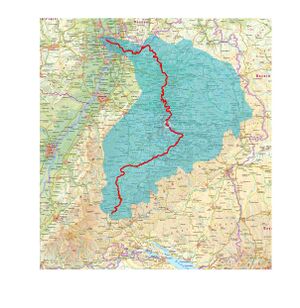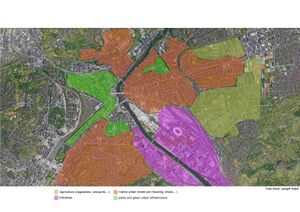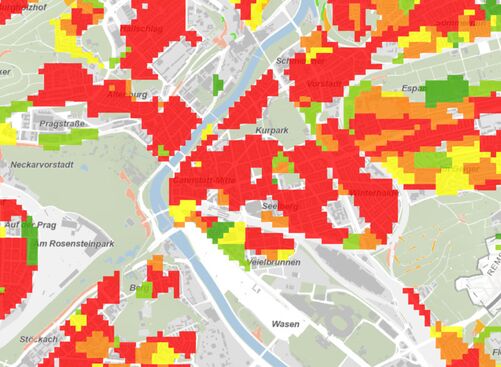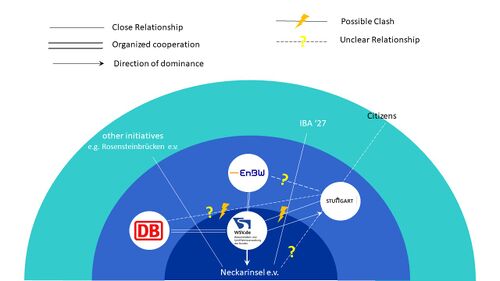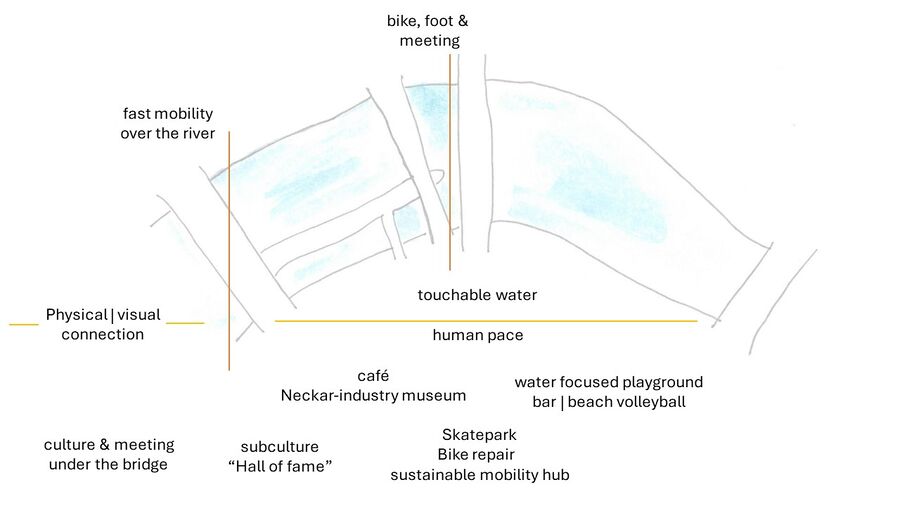WAVE Case Study Neckarinsel Stuttgart
>>>back to working groups overview
| Area | Neckar Bad Cannstatt | |
| Place | Stuttgart | |
| Country | Baden-Württemberg, Germany | |
| Topics | Re-Connecting to the Neckar | |
| Author(s) | Anna-Kathrin Schneider | |
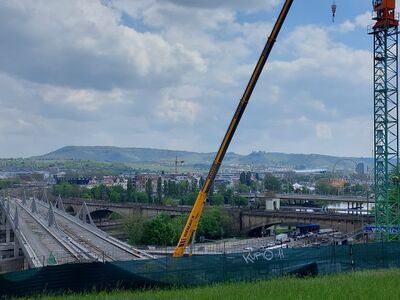
| ||
Rationale
The Neckar is included and fit into human usages in the area, where its passing though Stuttgart and it divides Stuttgart Bad Cannstatt from the inner city. Through that the study area is a point of connectivity and mobility in each manner. In history the people in charge of of the urban water site switched and now multiple stakeholders are somehow connected to that. For the inhabitants the study area is just a point of crossing and moving, while totally disconnected to river. Moreover, in the future there will be a shift of usages of railways, new ones are under construction right now, additionally the contracts for electric power generation with the big companies will end 2034. These shifts could be used to re-shape and re-connected the people to the river.
Location and scope
You can edit this map with the map editor
Water as a natural system
Geomorphology, typologies and dynamics of water areas
The Neckar flows from its origin near Schwenningen to Mannheim, where it leads into the Rhein. It thus covers a distance of 371 km and a difference in altitude of 621 m.
The development of the catchment area started already in the Cretaceous period with the cave in of the Oberrheingraben and the beginning rise of the Swabian Alb. Consequently, the catchment areas of Danube and the earlier river Rhein changed. The Neckar receives its water now from 13.600 sqkm catchment area. Important is the perception minus evaporation in that area. The water level therefore depends highly on weather, so seasonal and shortly changes are visible. The average yearly perception in the catchment area are between 600mm to 800mm.
Water as a living space
In Stuttgart's urban environment and due to the expansion of the federal waterway, the Neckar has been increasingly forced into a built corset in recent centuries. Nature conservation and environmental protection, as well as biodiversity, hardly played a role. North of Stuttgart, between Aldingen and Stuttgart-Mühlhausen, lies the nature reserve "Oeffinger Scillawald". It is named after the large occurrence of blue star and consists of a deciduous forest that used to be frequently found along the Neckar. This is the only nature reserve along the Neckar near Stuttgart. Up to Plochingen, the end point of the waterway, the river and the riverbank are industrially used and deformed.
In addition to the Neckar, there are 16 other streams in the Stuttgart area. Their total flow length is approx. 150 kilometres, the longest stream being the Feuerbach with a length of 11.5 km. There are also other standing waters in the Stuttgart area. The largest lake is the Max-Eyth-See with an area of 17.3 hectares. (State Capital Stuttgart Civil Engineering Office (2020): Portrait of Stuttgart's water bodies)
The water quality of the Neckar suffered and still suffers from the various industrial uses and structural changes. The 27 barrages slow down the flow, which can lead to a lack of oxygen as there is no longer any turbulence. The critical mark is below 4mg oxygen/litre (LUBW; https://www.lubw.baden-wuerttemberg.de/wasser/chemischer_zustand).
Likewise, sewage treatment plants discharge their treated wastewater into the Neckar, but polluted water is still fed into the river. Swimming in the Neckar is therefore not recommended.
Furthermore, rising temperatures affect the water temperature and thus the ecological condition of the water body. The critical mark of 28° degrees should not be exceeded. However, the water of the Neckar is used as cooling water by the industries on its banks. If the water temperature rises, the power plants must reduce their output in order to protect the "Neckar" habitat. (Regierungspräsidium Stuttgart (27.08.2018): Hohe Temperaturen im Neckar: Regierungspräsidium erteilt Ausnahmeerlaubnisse für drei Kraftwerke der EnBW, Pressemitteilung). The following graphs show how precipitation in the Stuttgart area affects the water temperature and oxygen content of the Neckar with a slight delay. The increased inflow of rainwater lowers the temperature and the increased flow velocity allows more oxygen to enter. The fourth graph shows the rising water temperatures over the course of the year.
Within the framework of the Baden-Württemberg Surface Water Ordinance, the Neckar in the urban area of Stuttgart is assigned to the fish community of the epipotamal. This fish community includes, for example, eel, bitterling, flounder, pike, rudd, tench and zander. The species-specific preferred temperatures for this fish community are up to 25° degrees in summer and up to 10° degrees in winter. (LAZBW(2020): Assignment of fish communities and resulting temperature requirements according to the Surface Water Ordinance in Baden-Württemberg)
Blue and Green Infrastructure
The Neckar river has a major function in the climatic situation of the urban area. Following maps from the City Surveyor's Office and Geoinformation show the climatic situation around the area and the impact of the river.
The build up area along the river is highly burdened with urban structures and resulting climatic conditions. The local residents are highly vulnerable towards climatic changes. And even the Rosensteinpark has a high exposure to heat in summer. Especially the old town of Bad Cannstatt and the residents there will have to deal with urban heat islands and therfore heat stress due to climate change.
The intense traffic and important mobility hub (bridges between Bad Cannstatt and inner city) lead to high noise pollution and the formation of nitrogen dioxide. The Neckar Island is also affected by this.
Do get an overview of the surrounding area and its function, the following maps show the categorized landuse as well as the sealed structures, like buildings, streets and railways. Also a few other water structures can be found in the neighbouring Rosensteinparc.
Also the little green infrastructre around the study area has a minimal function as a carbon store. Two calculations were made with the help of the itree canopy calculator. The first shows the mobility node (study area). The second one is for comparison and was created in the Rosenstein Park.
At the study site there is over the half coverd by impervious roads and buildings (64%) and just 8% are covered by trees/ shrubs or Grass. The Rosensteinparc shows completly the opposite situation with a tree and grass coverage of ~95%. Looking at the reference area in the parc we can find ~214 tonnes of carbon stored in trees, which equals ~785 tonnes of CO2. Annually there is ~31 tonnes of CO2 sequestered in trees. Taking the CO2 price of the german government 25€ per ton, the parc is having a financial effect of 775€ CO2 per year.
The study site on the other hand has stored just ~42 tonnes carbon, which equals ~154 tonnes CO2 and is sequestering annully aprox. ~6 tonnes of CO2. Turning that into financial terms the study site has just an effect of 150€ a year. Very important is to understand here, that the CO2 which is produced by the cars everyday is not included in the calculation. Otherwise the financial effect would turn even worse into a negative value.
Water as a cultural space
Land use and water
The Neckar has always represented an important landscape marker and use. For example, the middle course (between Rottenburg and Bad Wimpfen) was the north-eastern border of the Roman Empire for seventy years. (LUBW 2007; p. 46f.) The Romans also navigated the Neckar with rafts. The first successful development of the river was achieved by the Duke of Württemberg in 1821. In 1878, chain-towed navigation opened between Mannheim and Heilbronn. The expansion of locks and weirs took until 1935. Then the shipping route from Mannheim to Heilbronn (113km) could be opened. The Second World War not only slowed down further expansion, but also destroyed many bridges. Motorboats then made it possible for a few people to cross. However, the expansion was resumed after the World War, so that the port of Plochingen could be opened at the end of the 20th century, making 201km of the Neckar navigable. The total of 27 barrages also function as hydroelectric power stations for generating electricity and almost all of them were designed by the architect Paul Bonatz. (leo-bw)
The Neckar is approved for large Rhine ships up to 110m in length and up to 3000 (t) in tonnage. (Classification of the federal waterway: Class V a).
The extract from the Digital Federal Waterways Map gives an overview of the shippable Neckar and the location of the barrages.
Masterplan "Neckar experience area" and the IBA projects
While, in the last century, the Neckar was increasingly adapted to the urban context and industrially deformed, a rethinking has taken place in recent years. Although it is not possible to simply create a meandering riverbed due to the still active industry and the dense settlement of the riparian areas, people have set out to return the first parts to nature to some extent or to enable contact between people and water. In 2015, the city of Stuttgart started a master plan "Erlebnisraum Neckar. A master plan for Stuttgart as a city on the river". In several project phases, ideas and visions of the Neckar in the Stuttgart area are to be implemented by 2035. The concept is based on five fields of action: Networking River,
- Urban and Landscape Space
- Meeting Points on the River
- City Edges on the Water
- Experience Industrial Culture in the Neckar Valley
- Ecosystem Neckar
More information on individual building blocks and graphics: https://www.stuttgart-meine-stadt.de/content/bbv/details/302?tab=0
In addition, the International Building Exhibition 2027 has dedicated a plenary session to the topic of the Neckar and the city on the river. Within the framework of workshops, discussions and artistic interventions, numerous ideas for a city on the river were developed and images of the future created. The focus is above all on reclaiming the Neckar as a living space. Ideas that have arisen that also affect this study area are, for example:
The Rosenteinline - the conversion of the (soon to be) old railway line into a bicycle lane. Or the bathing ship at the Neckar Island, which would not only make it possible to experience the river, but also in the river.
More about the plenum and the individual ideas: https://www.iba27.de/themenraum-neckar/
Visual appearance and landscape narrative
The river also played a role in poetry.
Friedrich Hölderlin a well-known German writer and poet lived from 1770-1843 and wrote a famous poem about the Neckar.
Der Neckar
(written around 1800-1806)
In deinen Tälern wachte mein Herz mir auf
Zum Leben, deine Wellen umspielten mich,
Und all der holden Hügel, die dich
Wanderer! kennen, ist keiner fremd mir.
Auf ihren Gipfeln löste des Himmels Luft
Mir oft der Knechtschaft Schmerzen; und aus dem Tal,
Wie Leben aus dem Freudebecher,
Glänzte die bläuliche Silberwelle.
Der Berge Quellen eilten hinab zu dir,
Mit ihnen auch mein Herz und du nahmst uns mit,
Zum stillerhabnen Rhein, zu seinen
Städten hinunter und lustgen Inseln.
Noch dünkt die Welt mir schön, und das Aug entflieht
Verlangend nach den Reizen der Erde mir,
Zum goldenen Paktol, zu Smyrnas
Ufer, zu Ilions Wald. Auch möcht ich
Bei Sunium oft landen, den stummen Pfad
Nach deinen Säulen fragen, Olympion!
Noch eh der Sturmwind und das Alter
Hin in den Schutt der Athenertempel
Und ihrer Gottesbilder auch dich begräbt,
Denn lang schon einsam stehst du, o Stolz der Welt,
Die nicht mehr ist. Und o ihr schönen
Inseln Ioniens! wo die Meerluft
Die heißen Ufer kühlt und den Lorbeerwald
Durchsäuselt, wenn die Sonne den Weinstock wärmt,
Ach! wo ein goldner Herbst dem armen
Volk in Gesänge die Seufzer wandelt,
Wenn sein Granatbaum reift, wenn aus grüner Nacht
Die Pomeranze blinkt, und der Mastixbaum
Von Harze träuft und Pauk und Cymbel
Zum labyrinthischen Tanze klingen.
Zu euch, ihr Inseln! bringt mich vielleicht, zu euch
Mein Schutzgott einst; doch weicht mir aus treuem Sinn
Auch da mein Neckar nicht mit seinen
Lieblichen Wiesen und Uferweiden.
(Source: https://www.textlog.de/17837.html#google_vignette)
Water and People
Accessibility and usability
Community Mapping
Social groups
- Pedestrian, cyclists, car drivers -> so everybody, who wants to cross the river
- As well as the young adults, youth and kids using the area under the bridge, where the “Hall of fame” is located, a legal graffiti place and a small skate parc.
Here we have two different needs, which seems to be contractionary. The first group wants to move, to cross the river. The second group needs a place to stay, meet and a place for subculture. Moving vs. Meeting
Local stakeholder groups
- Federal Waterway administration – they are responsible for the locks and the weir, as well as for the peripheral areas and the operation of the ship. Accordingly, responsibility over the river is not in the hands of the city, but in the hands of the federal government.
- EnBW – they have the contractual right to generate electricity from the Neckar until 2034.
- Deutsche Bahn – they are building a new bridge and still have the old one running. The trains are crossing the river in a constant manner. The construction site is part of the overall project Stuttgart 21.
- The public transport company – is on the one hand using the railways of the Deutsche Bahn, but also the rails on the federal road.
- State of Baden-Württemberg – the street guiding over the river, connection Bad Cannstatt and Stuttgart, is state-owned.
- several departments of the city of Stuttgart – the role of the city is very complex, as neither the road, nor the bridge, nor the river, is properly their responsibility. However, urban drainage, industry and thus taxes, flood protection, road and traffic planning, etc., are very much aspects that the city coordinates and which all apply to the research area as well.
External stakeholder groups
- Neckarinsel e.v. – a local association, which wants to regain the Neckarinsel as a public space and reconnect the people to river. Their vision is a water sensitive city.
- Rosensteinbrücken e.v. – they want to transform the (soon) old railway bridge into a bike lane with green infrastructure and meeting points through benches.
- Neckarfreunde – would like to install a floating public swimming pool. Their goal is to reconnect to the river and thereby strengthen the desire for better water quality.
Conflicts
Several stakeholders have access to the changes in the study area - who is responsible for what and how the future is shaped depends not only on local decision-makers but also on national directives. A discourse that has been discussed for years but is still very unclear revolves around the locks. According to the federal government, these would have to be expanded and lengthened for larger ships, but the listed railway bridge might have to be altered or demolished for this. The railway bridge will be replaced in the near future by the new bridge, which is already almost finished. Moreover the old bridge has the status of cultural heritage. There are already ideas to convert the old bridge into a bicycle lane, which will connect the Rosenstein Park and the development area there with the Gleisdreieck area through the tunnel. However, as soon as the railway no longer needs the bridge and sells it to the city, a new crossing right must be negotiated with the federal government (waterways department). Here the confusion connects to the expansion of the locks becomes clear, which is actually a demand of the federal government.
The situation becomes even more complex when one takes into account that in 2034 the contracts for power generation on the Neckar between the Water Management Office and EnBW will expire. EnBW built and operates the locks and weirs along the Neckar. As a result, there is (still) no national administrative unit that will take over responsibility for the existing infrastructure once the contracts expire.
This very unclear and delicate situation shows the confusion and the conflicts of power and use that can determine and change such a small area.
And with in these fabric of linkages there is the social initiative Neckarinsel e.v., which wants to regain public space, reconnect the people with the Neckar, collecting data about the ecological conditions of the water and educating the people about it.
Questions and problems
arising from this stakeholder constellation include:
- How do the residents want to live on and with the river in the future?
- What role can the river and its banks play in a climate change-adapted urban design?
- How will industry develop along the Neckar in the future? Will the inland waterway transport network continue to be used and possibly even expanded, or will it no longer be needed?
- Will we be dependent on the electricity produced there? Especially with the current tense political situation, this is a thoroughly uncertain aspect.
The last two questions in particular and the associated development directions have a great influence on the relationship between the stakeholders and the access and power relationships.
As the DPSIR analysis and the description of the stakeholders show we have two contradicting needs. There are groups/ stakeholders which see the river as a mobility obstacle, that needs to be crossed, or as a way of transportation. On the other hand, there are people that want to stay, meet, get in contact with the water, on whose shores they live.
Moreover, the shift of mindset regarding our dealing with water and urban rivers changed. The importance of functioning ecosystems that are not industrially abused and threatened is in everyone's minds, and so in recent years there has also been growing pressure at the political level to change the landscape along the water and rights of use and access.
Possible Futures
The analysis of the study site and the surrounding needs and interest lead towards three main aspects. First the study site does play an important role in the mobility and connectiveness of the city. Even though mobility patterns are changing not just in a mental shift within society but also in the build environment in Stuttgart itself. Nevertheless, the bridge and the mobility hotspot will obtain, with the change that there might be new ways (old railway as a bike lane e.g.) and a different order and ranking of the user’s importance.
The other point is the also obtaining shipability of the Neckar. Even though the contract of EnBW regarding the usage of the river for power generation might end in the next years, with the current political situation water electricity isn’t a topic to forget about. The worst scenario that could occur is to even expand the bridges and building a lit over the river - according to the motto: Out of sight, out of mind. Or, if not needed anymore, just forgetting about industrialized water banks, creating abandoned and broken industry. (Scenario 1)
But there are additionally the cultural and social aspects of nature and water experience, recreation and the positive climate impact, which, within scenario one, would not have been taken into account. Focusing on these aspects and looking at the four ecosystem services I created three other scenarios.
River and Society
By creating a living citizens science island the Neckarinsel could be function as a space for learning and experience the Neckar and life along it. The area could be accessed from the bike lane (old railway line) and through a leveled site area the different water levels could be experienced. Also established container could function as experimental and interactive museums and citizen research centers to learn more about the river and its interwoven history with the human along it. (Cultural Ecosystem service)
Edible island
Focusing on the provisioning ecosystem service the island could offer a space for a community garden in raised beds, boxes and sacks, similar to the Prinzessinnen gardens in Berlin.
Both scenarios create a space for people in a forgotten and industrialized river that is unseen and interwoven with the city and otherwise always passed over. For the neighborhood, a place of relaxation and nature can be created here without having to take the long way across the bridge. The place also attracts people from the surrounding area and creates the opportunity to encounter strangers - exchange and contact are created. An island of tranquility in all the hustle and bustle of the frenetic mobility above.
Fragmentation and Diversification
Along a meandering riverbank there normally emerge different habitats for a variety of species. Given that the Neckarisland as such can not be taken down and due to ongoing industries and close building structures the river cannot be taken out of the built corset. But the island could break down into a collection of differently leveled islands on which trees and bushes grow. Between the areas of green infrastructure, water can find its way and create small microhabitats for different species. That might not just increase the biodiversity in the water, but also, through the active plantation of trees and shrubs on the islands, the variety of species above the water can grow. Also, the carbon sequestration could increase and counteract in a really small amount the massive CO2 production through traffic.
Collaborative Goal Setting
- Keeping a mobility connection between Stuttgart and Bad Cannstatt, in which we create space for meeting and social exchange through green and cultural infrastructure
- Supporting sustainable mobility patterns
- Furthermore we want to establish a connection between human activities and the river -> reconnecting the people to the river by creating access and education about the past, the present and the future of the relationship between the city/ humans and the river Neckar
Spatial Strategy and Transect
The vision is to develop a special design, that strengthens the quality of places to stay and connect (visually and physical) to the river, by still keeping the mobility over the river alive and even supporting sustainable mobility patterns through vibrant routes that are attractive due to green and cultural infrastructures. We want to establish a connection between human activities and quality of the river.
Therefore, the first graphic gives an overview of two transects. One along the river and one crossing the river on two different bridges. Looking at the usage change by crossing the river first it needs to be mentioned, that there are three levels of mobility. In the top level (on the bridges) there are fast moving vehicles dominant (cars, public transport and train), under the bridges and along the river there is a small space just for bikes and pedestrian. This space must, however, be shared by both. The third level is not only demarcated by a difference in height but above all by physical and visual barriers. Between sidewalk and river, where the shipping mobility is taking place, is a fence, a wall and a hedge, which make it impossible to go directly towards the river or mostly even see the river.
On the second level (level of human pace) you can find subculture, like graffiti under the bridges. Especially the area under the König-Karls-Brücke is a place for legal urban art and is also called “Hall of fame”. Continuing the way along the river towards the old and new railway bridges the space isn’t used. The only thing you can do is to continue your linear moving. After the bridges the space on the right hand is opening up and turning greener. You can find a small beach bar with a volleyball field and a playground for kids. But most of the time the river isn’t visible, and the sealed footpath is a creating a second barrier, next to a fence and a hedge, towards the river.
How to change and implementing the vision with the subgoals. The vision-graphic shows some possible changes, which could interrupt the linear flow of human paced movement and create places with meeting qualities. Therefore, at the space between the first and the second bridge you can use the old garages opening a small café and a open museum, telling the story of the relationship between humans and the Neckar. Including greening would highlight the nature-bounded atmosphere and create a audible and visual buffer towards the streets around. As a side effect that would increase the habitat for birds and create a better biodiversity. Additionally, the cultural upgrading would invite people to come and visit the Neckarisland, given that the entrance is between the two garages. It would also support using bike or going by foot given that you would have the possibility for a coffee, a cold drink and a little snack.
Under the new build railway bridge is space for a covered skatepark and workout area, that also can be used if its raining. Moreover to support sustainable mobility pattern a small public bike-repair station could be installed. Or thinking even futher, it would be possible to establish a mobility hub, where you can rent (e-)bikes and segways. The space along the river could be opened up visually, but also physically in terms of overing the people the possibility to move even closer towards an industrialized riverbank.
The suggested changes can create horizontal axes, which can interrupt the linear flow and give possibilities for meeting and interaction, without interfering in the river-crossing (fast) mobility.
Different spatial levels of mobility - the fast movements (cars, U-Bahn, Train,...) and the connection between Stuttgart city and Bad Cannstatt will be on the level of the bridges. The space under the bridge are used for meeting, graffiti, for moving in human pace along the river and experiencing the water.
From Theory of Change to Implementation
1. Step one: bring the river to the people …
2. Step tow: take the people to, on, along the river …
3. Step three: let use discuss and act
… creating the future together.
For most of the people the Neckar within Stuttgart is something they just need to cross. It is hidden behind industry, hedges, or fences. To raise the awareness of the living ecosystem – why not bringing the river in the surrounding neighborhoods? Together with schools, kindergartens, and artists there could be a Neckar Art Exhibition in unused houses as an interim usage. For example, the old Kaufhof building in Bad Cannstatt right now is a vacant building in the middle of the district, huge and like a wound. Instead of leaving it unused there could be opened up a pop-up Neckar exhibition including history, sciences but also local art. Not just an attraction for Bad Cannstatt, but also providing impetus for thoughts. There can be public talks and discussions, collecting ideas from the politics, economics, sciences and people.
After educating the people, they might want to come by themselves already – let’s invite them to, on and along the river. Starting a real-world experiment and trying some ideas – who would it be to install a mobility hub and a skate park under the new bridge? If the old railway bridge isn’t used anymore – how could it be driving the bike on it? Or maybe starting a small Food truck Café along the lock side. Swap your office one day a week for the island and join the Co-Working Island? Yoga between the waves? Also, the university can use the space for (public) outdoor lectures (like they do it at the University in Klagenfurt, Austria).
All this pop-up, experimental ideas can turn into permanent solutions and through the work the network can be strengthened, and important stakeholders can be included. These temporary changes can show what is possible at all political levels and provide inputs for innovative cooperation, to shape a sustainable Neckar within Stuttgart.
References
- WSA Neckar. Online: https://www.wsa-neckar.wsv.de/Webs/WSA/Neckar/DE/Startseite/startseite_node.html
- Landeshauptstadt Stuttgart (2017): Erlebnisraum Neckar. Ein Masterplan für Stuttgart als Stadt am Fluss.
- LUBW (2007): Der Neckar. Das Land und sein Fluss.
- leo-bw.de: Staustufen, Schiffsverkehr und Kraftwerke. Online: https://www.leo-bw.de/themen/natur-und-umwelt/neckar/staustufen-schiffsverkehr-und-kraftwerke
- © 2022 Landeshauptstadt Stuttgart; Straßen‐ und Wegenetz: © ODbL1.0; Nutzungsflächen aus Basis‐DLM: © LGL‐BW. Online: https://gis6.stuttgart.de/maps/index.html?karte=umwelt&embedded=false#basemap=0
- https://canopy.itreetools.org/
- Interview with IBA '27 responsobile, Mrs. Pinell
- Interview with Neckarinsel e.v.
- http://neckarinsel-stuttgart.de/
Process Reflection
- Reflect in your intercultural and interdisciplinary team on the outcomes of your study
- Which limitations were you facing?
- What have you learnt from each other?
- What did you learn in the Living Labs?
- What would you do differently next time?
- You can also use diagrams/visuals
- 250 words text
